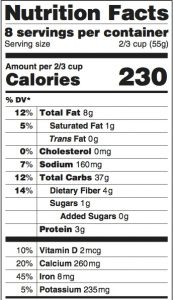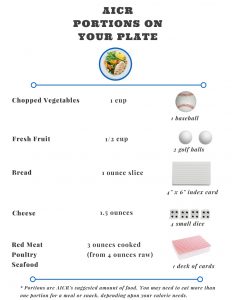If you saw this label on a food you were about to eat, how would you interpret the serving size? If you’re like most people, you would say that 2/3 cup is the recommended serving for this food, and that common  misinterpretation may soon lead you to eat more than you should when the nutrition label serving sizes boost upwards, suggests a recent study published in the journal Appetite
misinterpretation may soon lead you to eat more than you should when the nutrition label serving sizes boost upwards, suggests a recent study published in the journal Appetite
This could cause the unintended consequence of weight gain. AICR’s first recommendation, maintaining a healthy weight, is one of the most important steps you can take to reduce cancer risk.
The serving size on the nutrition label – that 2/3 cup – actually represents the amount most people eat in one sitting. And it’s about to change for about one in five food items as part of the FDA plans to revise the label. We wrote about it here. The proposed label will adjust the serving sizes to more accurately represent what people typically eat, which is more than the current serving sizes. For example, the serving size for ice cream would increase from one-half cup to one cup.
This change could help people better understand how many calories and nutrients are in the amount of food or beverage that they actually eat or drink. However, the authors of this study wanted to test whether this change could also cause people to purchase or serve larger portions for themselves or others.
In one of a series of experiments, the authors gave 101 participants a nutrition facts label for a can of soup. Half the participants saw the current nutrition facts label and half the participants saw the new nutrition facts label with a larger serving size. Participants were then asked what they thought the serving size on the label meant. Approximately 80 percent of both the group who saw the current label and the group who saw the new label answered incorrectly that the serving size represents the amount that can or should be consumed in one sitting as part of a healthy, well-balanced diet.
Next, the authors gave 51 participants a nutrition facts label for packaged cookies. Half the participants saw the current nutrition facts label with a serving size of 3 cookies and the other half saw the proposed label with a serving size of 6 cookies. When asked to serve themselves, those who saw the label with the larger serving size selected an average of about two and a half more cookies than those who saw the label with the smaller serving size.
In another experiment, the researchers asked 61 participants to select how many lasagnas they would purchase for a group. Those who saw the label with the larger serving size said they would purchase an average of about two additional lasagnas and would cut each lasagna into fewer slices compared to those who saw the current nutrition facts label.
According to the authors, these results suggest that larger serving sizes may lead consumers to purchase and serve more food for themselves and others.
To prevent these unintended consequences, the authors suggest educating consumers about what the serving size actually means and why it is not a recommendation for how much you should eat.
But that may leave you wondering: where should you be looking for this information?
 AICR has information on standard portion sizes that’s a good starting point. You may need to eat more or less than one standard portion depending on your sex, age, activity level, and many other factors. USDA’s SuperTracker takes these factors into account and provides you with more tailored guidance about portion sizes and food groups.
AICR has information on standard portion sizes that’s a good starting point. You may need to eat more or less than one standard portion depending on your sex, age, activity level, and many other factors. USDA’s SuperTracker takes these factors into account and provides you with more tailored guidance about portion sizes and food groups.
Participating in AICR’s New American Plate Challenge, an online program focused on eating smarter, moving more, and managing your weight is another great way to educate yourself. Simple changes like using smaller plates, splitting restaurant meals, and tuning in to your hunger and fullness cues can also help.






Thank you for pointing out that reading the nutritional facts can help you understand calories and nutrients. Knowing what you are eating seems very important. Hopefully, people look into getting the best nutritional facts possible.